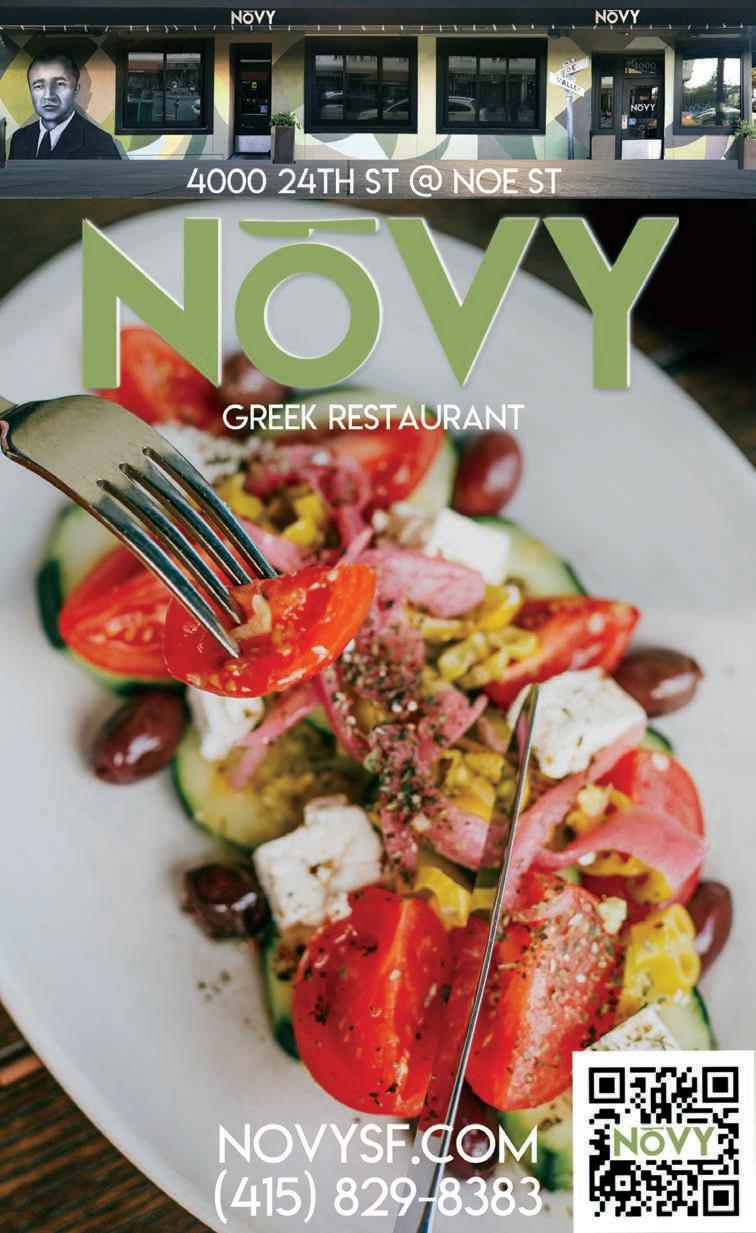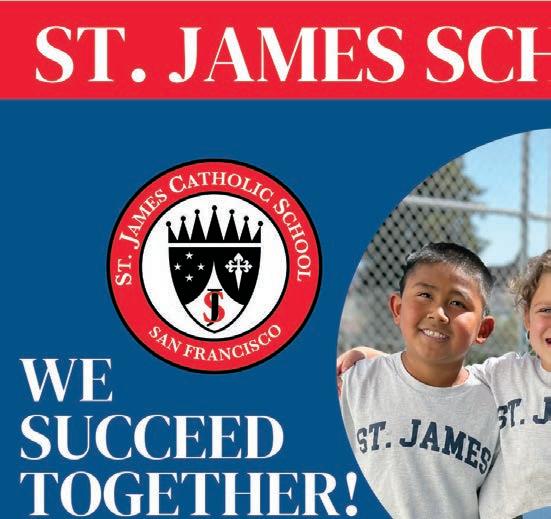
6 minute read
Why I Choose to Raise My Family in San Francisco
have given our kids the foundation and perspectives we wanted.

Advertisement
Events like the Bring Your Own Big Wheel race, Potrero Hill Festival, Halloween and Piano on the Hill are amazing opportunities for the kids to hang out with their friends and us parents to connect with our neighbors. Just walking down 18th or 20th streets on a typical day usually ends up with us running into someone and stopping for a chat.
Supporting local businesses is a family affair. The kids love sauntering into Chiotras Grocery and being greeted by name as they pick out an after-school treat. We’ve had so many great experiences with neighborhood restaurants handling our kids with patience when they were younger and now respecting them as burgeoning foodies as they learn to order for themselves.


We’ve enjoyed becoming involved with our neighborhood. Matt has served on the Starr King Open Space board for thelast five years, working to maintain a neighborhood treasure. Two favorite aspects of my career in real estate is that it allows me to show off our City to recent transplants and to advise families on the many programs available to enable them to stay in San Francisco and build equity.
We try to show by example that San Francisco can be a wonderful place to raise kids. We look forward to our family’s next phases of tweens and teens learning to make their own way in a city that truly has something for everyone.



BY JOAN MEYER
When I moved to Potrero Hill in 2006 I was single. I didn’t know much about the neighborhood other than the Bottom of the Hill music venue. I certainly had no idea I’d still be here 17 years later living happily with my husband, Matt, and two children, Collin, 10, and Audrey, eight.
Matt and I were both raised on the Peninsula, where our parents still reside, but we knew that we wanted to raise our kids in the City. We wanted them to grow up in a diverse, exciting place with exposure to the arts, food, culture, community, as well as real world issues, to enable them to have empathy, compassion, understanding and life skills you just don’t get in the suburbs.
What we didn’t know was how lucky we were to be in Potrero Hill when we had children. We were afforded all the benefits of living in a large city with the comfort of residing in a small-town community. Hanging out at McKinley and Jackson parks, attending Friends of Potrero Preschool and the Spanish Immersion Program at Daniel Webster Elementary and utilizing the incredible San Francisco Recreation and Park programs have introduced us to many other families in the neighborhood and
ARTISTS from front page
Coombs, and Jean Halbrok-Ryden. Gordon Woods, a sculptor who also directed the California School of Fine Arts, now known as the Academy of Art, built “standards,” or movable wooden boards to create more wall space to display artwork between the library bookshelves. Now the renovated library can show works without extra shelving.
Artists no longer donate pieces to fundraise for the library. Instead, the exhibition is a community celebration; the artwork is merely borrowed for a few months.
The family-friendly reception will include wine, non-alcoholic drinks, kid-friendly foods, and stations where children can make art they can take home. Josh DiChiacchio will serenade patrons on the classical guitar. In the background, a digital slideshow will depict old photographs of the exhibition, previous flyers, with most illustrations penned by Nell Jehu, and a video of the 1985 art show.
“We think this is the longestrunning annual art exhibition in San Francisco,” Bradshaw said. “Call me corny, but I think it’s cool to be a part of that history and for the library to be a part of that history for all 68 years.”
For more information, email potmgr@ sfpl.org, call the library, or come by and ask in person.
UNACCEPTED STREETS from front page sylvania Avenue, from roughly addresses 0 to 184, north of Mariposa Street. It is a main bike route in and out of Dogpatch to 17th Street and Seventh Street,” said Doumani.

This section of Pennsylvania Avenue is poorly paved, with parking on both sides of the street.
Donovan Lacy, DNA vice president and co-chair of The Potrero Boosters and DNA joint Livable Streets Committee, is concerned that the southeastern neighborhoods have many more unaccepted streets than other parts of San Francisco.
“For too long, we’ve let these languish. For a city that has as much money as we do, it’s a concern. All City streets should be maintained to a certain level. These are not,” said Lacy.
It can take time and advocacy effort to get an unaccepted street accepted and maintained by Public Works, said Alice Rogers, president of South Beach|Rincon|Mission Bay Neighborhood Association (SBRMBNA). According to Rogers, South Beach is among San Francisco’s densest populated area, with a plethora of poorly maintained unaccepted streets.
“In Mission Bay, the issue is equally acute for the newly constructed roadways and parks. It can take more than a year for the redeveloped public amenities to be accepted and opened to the public for use,” said Rogers.
If a paper road isn’t sufficiently improved to become a standard street, community groups or developers can advocate for it to be utilized as a staircase, pedestrian pathway, or other purpose.
“These streets could become green spaces for public use,” said Tom Radulovich, director of planning and policy for the nonprofit Livable City. “That would enhance the quality of life in the City. Currently, there’s a big disincentive for property owners next to unaccepted streets to get involved. This is because they have to assume liability for improvements. Public Works will repave an unaccepted street and clean trash off it one year and not the next. There seems to be no schedule. There could be a regular schedule and notifications for neighbors who want to help.”
“Neighbors who have concerns regarding illegal dumping can contact Public Works or call 311,” said Jennifer Friedenbach, San Francisco Coalition on Homelessness executive director. “Concerns about unhoused people… should contact the San Francisco Homeless Outreach Team of the San Francisco Department of Homelessness and Supportive Housing. They can connect folks with services and work on trash removal.”
“SFPA is available as a guide and fiscal sponsor to assist residents with applying for grants and figuring out solutions for unaccepted streets,” Kearstin Krehbiel, chief strategy officer for San Francisco Parks Alliance (SFPA), which acts as a fiscal sponsor for organizations that want to maintain or improve public spaces. “We’re here to imagine with residents what could be possible. Ideas include informal gardens, natural areas, walking paths, and vantage points.”
SFPA has worked with residents to improve unaccepted streets in Southof-Market, Bayview-Hunters Point, and Potrero Hill, among other neighborhoods. SFPA fiscally sponsors the De Haro Street Community Project, a group of neighbors improving the median that divides upper and lower De Haro Street on the 1300 block. This entire block of De Haro Street is unaccepted.
In 2022, the De Haro Street Community Project received a $150,000 Community Challenge Urban Watershed Stewardship Grant from the San Francisco Public Utilities Commission (SFPUC) to mitigate erosion and runoff on lower De Haro Street. The group has applied for a second grant to finish the project, monies from which could also help address concerns on upper De Haro Street.
“Upper De Haro Street is falling into the median and there is not a guardrail for cars,” said Katie Cariffe, a De Haro Street Community Project member.
Cariffe said neighbors would prefer to remove the pavement in the path and build a solid retaining wall to prevent traffic accidents. This would be expensive because mitigation would be needed to prevent naturally occurring asbestos in serpentine rocks from rising up in dust clouds. Asbestos has the potential to endanger residents and pedestrians.
The De Haro Street Community Project will use funds from the first SFPUC grant to build a living wall, as well as a gravel bioswale – a channel to concentrate and convey stormwater runoff – and infiltration planter; a water retention area filled with grasses to clean and detain runoff by allowing water to soak into the surrounding soil.
Residents can learn more about requirements for accepted streets and steps to get a street accepted at: https:// sfpublicworks.org/services/acceptance.
STOLEN from front page dashed when she inspected the U-Haul. The thieves left two broken couches, a wrecked dresser, empty boxes, a USB drive containing photos, and one bag of baby toys.
“They took my wedding dress,” Borbon said. “They took everything I had. I feel so violated to have someone even steal the baby’s clothes.”
Nor was the U-Haul drivable. The










